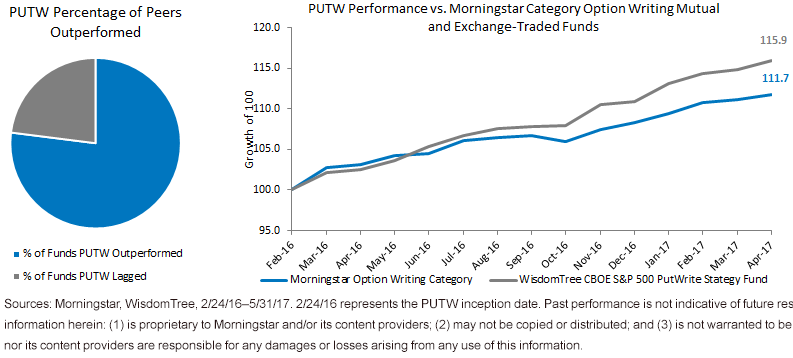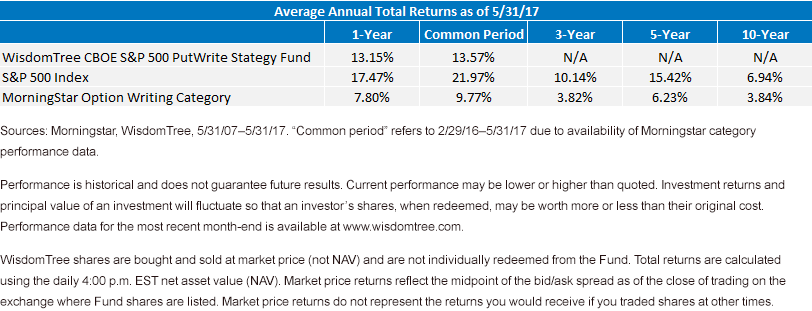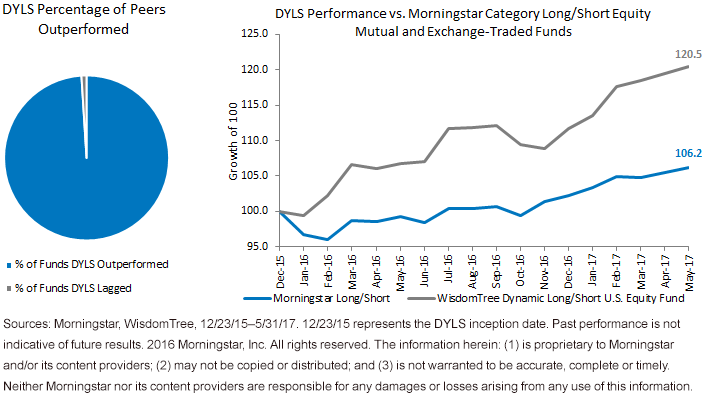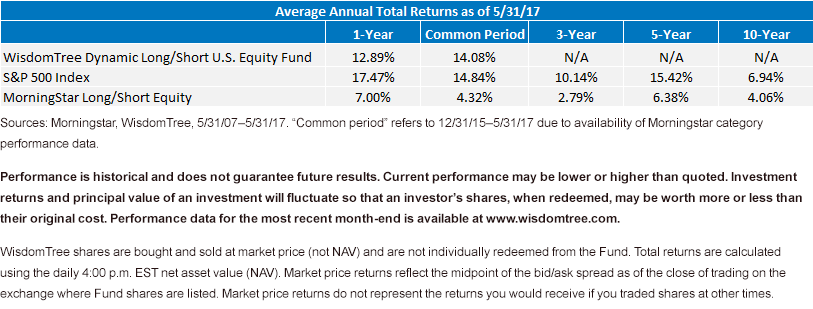Two Strategies for Managing the Volatility of U.S. Markets


It has been some time since we last saw a reasonably sized pullback in the U.S. markets. We all know it is just a matter of time before it happens, and the latest moves in a number of the high-flying tech stocks have the chatter mills going into overdrive.
While the markets remain robust, it is a good time to consider alternative strategies that could help mitigate downside volatility. Two strategies, I believe, are particularly relevant today: PUTW, the WisdomTree CBOE S&P 500 PutWrite Strategy Fund, and DYLS, the WisdomTree Dynamic Long/Short U.S. Equity Fund.
Option #1 for Managing Downside Risk: PutWrite Strategy Fund
Those who believe the upside gains in the market are limited should consider a put-write strategy fund like PUTW that effectively sells at the money put options on a monthly basis and collects the option premiums—capping upside participation in the market but historically protecting on downside. Especially if the down market that inevitably arises brings with it a rise in volatility, the option premiums collected by PUTW are apt to increase from today’s low levels. Downside risk, of course, will bring losses on option premiums, but over time we believe this strategy has the potential to garner market-like, S&P 500 returns as a function of the option premiums PUTW can collect, and it can do so with lower volatility levels.


For standardized performance and other information regarding the fund please click here.
Option #2: Long/Short ETF
Low-cost1, daily-liquidity, alternative strategy funds are one of the areas where I see exchange-traded funds (ETFs) continuing to develop innovative solutions. At the end of 2015, WisdomTree launched DYLS, the WisdomTree Dynamic Long/Short U.S. Equity Fund. This Fund utilizes a dynamic market-hedging indicator and a rules-based index strategy that determines its exposure to the equity markets.
DYLS was fresh out of the gate and fully hedged in January and February 2016. It was a volatile time in the equity markets and a good time to have a market-neutral hedge in place. DYLS went unhedged in 2016 after the market close on March 2 and remained unhedged for the remainder of 2016 aside from November, adding a 50% hedge ratio just this June. This half hedge on the market was based on the earnings momentum component of the model losing steam and valuation levels being stretched, with the recent strong earnings gains coming up against tougher competitive benchmarks from past metrics.


I believe both of these funds are expected to have lower beta and market risk—strategies that are worth considering with markets at highs and widespread discussions concerning valuations of the U.S. markets.
- At least as of this June, DYLS’ net equity position has a 0.5 beta, and its beta since its launch, interestingly enough, has also been 0.5. But this 0.5 beta makes it one of the top performers in the entire category of long/short funds, beating 99% of its peers since inception. What I really like about the long/short strategy is that this fund also has lower market multiples and higher tilts toward quality stocks—which could also be beneficial in any market volatility environment.
- Option Writing Category: PUTW was launched three months after DYLS and has 15 months of real-time performance. Since its inception, PUTW has beaten 77% of its peers in the Morningstar Option Writing category, with a cumulative performance advantage of 380 basis points (bps) over its Morningstar peer group category average.
In summary, both of these funds are options for investors considering how to manage downside risk in the equity markets. Both strategies are designed to lower equity beta while also achieving long-run equity market upside participation.
1Ordinary brokerage commissions apply.
Important Risks Related to this Article
There are risks associated with investing, including possible loss of principal. The Fund will invest in derivatives, including S&P 500 Index put options (“SPX Puts”). Derivative investments can be volatile, and these investments may be less liquid than securities, and more sensitive to the effects of varied economic conditions. The value of the SPX Puts in which the Fund invests is partly based on the volatility used by market participants to price such options (i.e., implied volatility). The options values are partly based on the volatility used by dealers to price such options, so increases in the implied volatility of such options will cause the value of such options to increase, which will result in a corresponding increase in the liabilities of the Fund and a decrease in the Fund’s NAV. Options may be subject to volatile swings in price influenced by changes in the value of the underlying instrument. The potential return to the Fund is limited to the amount of option premiums it receives; however, the Fund can potentially lose up to the entire strike price of each option it sells. Due to the investment strategy of the Fund, it may make higher capital gain distributions than other ETFs.
The Fund invests in derivatives, including as a substitute to gain short exposure to equity securities. Derivatives used by the Fund to offset its exposure to market volatility may not perform as intended. The Fund may engage in “short sale” transactions and will lose value if the security or instrument that is the subject of a short sale increases in value. A Fund that has exposure to one or more sectors may increase the Fund’s vulnerability to any single economic or regulatory development. This may result in greater share price volatility. The composition of the Index is heavily dependent on quantitative models and data from one or more third parties, and the Index may not perform as intended. The Fund invests in the securities included in, or representative of, its Index regardless of their investment merit, and the Fund does not attempt to outperform its Index or take defensive positions in declining markets. Please read the Funds’ prospectuses for specific details regarding the Funds’ risk profile.

Jeremy Schwartz has served as our Global Chief Investment Officer since November 2021 and leads WisdomTree’s investment strategy team in the construction of WisdomTree’s equity Indexes, quantitative active strategies and multi-asset Model Portfolios. Jeremy joined WisdomTree in May 2005 as a Senior Analyst, adding Deputy Director of Research to his responsibilities in February 2007. He served as Director of Research from October 2008 to October 2018 and as Global Head of Research from November 2018 to November 2021. Before joining WisdomTree, he was a head research assistant for Professor Jeremy Siegel and, in 2022, became his co-author on the sixth edition of the book Stocks for the Long Run. Jeremy is also co-author of the Financial Analysts Journal paper “What Happened to the Original Stocks in the S&P 500?” He received his B.S. in economics from The Wharton School of the University of Pennsylvania and hosts the Wharton Business Radio program Behind the Markets on SiriusXM 132. Jeremy is a member of the CFA Society of Philadelphia.

